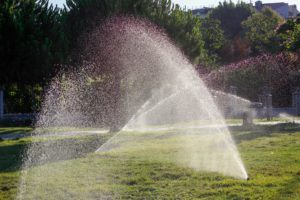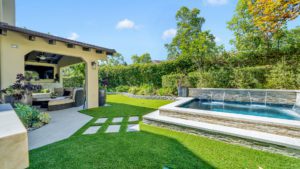Artificial Grass vs. Natural Grass: What’s Best for Your LA Home?
Introduction to Artificial Turf and Natural Grass
When it comes to creating a beautiful lawn, homeowners in Los Angeles have two main options: artificial grass and natural grass. While natural grass has been the go-to choice for decades, artificial turf, also known as synthetic grass, has surged in popularity recently. This rise is largely due to its low maintenance requirements and eco-friendly benefits, making it an attractive option for busy homeowners and commercial properties alike.
Artificial turf is a man-made surface crafted to replicate the look and feel of natural grass. Made from synthetic materials like polypropylene or polyethylene, it’s commonly used in sports fields, playgrounds, and residential lawns. Its durability and minimal upkeep make it a favorite for those who want a lush, green lawn without the hassle.
On the other hand, natural grass is a living, breathing entity that requires regular care to stay healthy. Comprising individual blades that grow from the soil, it needs consistent watering, mowing, and fertilization. Despite the effort, many homeowners and commercial properties prefer natural grass for its authentic beauty and the habitat it provides for local wildlife.
When it comes to landscaping in Los Angeles, homeowners are faced with a crucial decision—whether to install artificial grass or stick with traditional natural grass. With the sunny weather and frequent droughts in Southern California, it’s important to weigh the pros and cons of each option. In this blog, we’ll break down the key differences between artificial turf and natural grass, helping you decide which is the best choice for your LA home.
Artificial turf has become increasingly popular for both residential and commercial landscaping projects. Its low maintenance requirements and durability make it an attractive alternative to natural grass. Additionally, artificial turf can be used in a variety of settings, from sports fields to home gardens.
One of the key advantages of artificial turf is its versatility. Unlike natural grass, which can be difficult to maintain in certain climates, artificial turf remains green and lush year-round. This makes it an ideal choice for areas with extreme weather conditions or heavy foot traffic.
Moreover, artificial grass offers a wide selection of options to suit different landscaping needs, ensuring that both contractors and DIY homeowners can find the right type of turf for their specific projects.
Water Usage
Artificial Turf: One of the most significant advantages of artificial turf is its lasting quality and water efficiency. With LA’s drought conditions and strict water regulations, artificial grass saves an average of 44,000 gallons of water per yearfor a typical household. No watering is needed, making it a great choice for homeowners looking to conserve water and lower their utility bills.
- Natural Grass: Natural grass requires consistent watering, especially in LA’s hot, dry climate. Keeping a lawn green and lush can result in significant water usage, which not only impacts the environment but also leads to higher water bills. In times of drought, maintaining a healthy lawn can be both costly and challenging.
Winner: Artificial grass (for water conservation)

Maintenance
Artificial Turf: Artificial turf is incredibly low-maintenance. You don’t need to mow, fertilize, or water it. Occasional cleaning and brushing are usually enough to keep it looking fresh and green year-round. For busy homeowners or those who don’t enjoy regular lawn care, this is a major benefit. Additionally, you can find all necessary products and services for artificial turf maintenance in one stop shop, making it even more convenient.
Natural Grass: Natural grass, on the other hand, requires regular mowing, fertilizing, aerating, and pest control. In LA, where warm temperatures encourage rapid grass growth, this maintenance can become time-consuming and costly, especially if you hire professional services to care for your lawn.
Winner: Artificial Turf (for minimal maintenance)
Aesthetic Appeal
Artificial Turf: Modern artificial turf has come a long way in terms of appearance. High-quality options are designed to mimic the look and feel of natural grass. However, some homeowners may still prefer the authentic texture and variability of real grass, especially up close. That said, artificial grass stays lush and green year-round, without any brown patches or bald spots. Additionally, artificial turf is versatile and can be used for various applications, including creating golf putting greens and other landscaping needs.
Natural Grass: Nothing beats the feel of real grass underfoot. Natural grass has a softer, more natural feel, and some homeowners love the look of freshly mowed grass. However, in LA’s climate, natural grass can develop brown patches during the summer or dry seasons, detracting from its aesthetic appeal.
Winner: It’s a tie! (Natural grass for texture lovers, artificial grass for year-round greenness)

Environmental Impact
Artificial Turf: The excellence of artificial grass lies in its superior product performance and significant environmental benefits, such as water conservation. While synthetic grass saves water, there are some environmental concerns to consider. It’s made from synthetic materials, and its production and eventual disposal can have an environmental footprint. However, by eliminating the need for pesticides and fertilizers, it avoids harmful chemicals running off into the ecosystem.
Natural Grass: Natural grass provides some environmental benefits, like cooling the surrounding air and supporting biodiversity. But to maintain a healthy lawn, many homeowners rely on fertilizers, herbicides, and pesticides, which can leach into local waterways, harming wildlife. Plus, the water and energy required to maintain a lawn add up over time.
Winner: Artificial Turf (for water and chemical savings)
Durability and Longevity
Artificial Turf: Artificial turf can last 15-20 years or more, even with heavy foot traffic. It’s also more resistant to weather changes, which means it won’t develop mud or puddles after rain. Additionally, it doesn’t suffer damage from pets digging or rough play from children. Customers also have access to a variety of resources and support for artificial grass installations, including expert guidance and an extensive video library.
Natural Grass: Natural grass can wear down with frequent use, especially in high-traffic areas like walkways or where pets roam. You may need to reseed or re-sod these areas frequently. It’s also susceptible to weather conditions, developing mud, brown spots, or bald patches during periods of heavy use or extreme heat.
Winner: Artificial Turf (for durability and longevity)
Cost
- Artificial Turf:
The initial cost of installing artificial grass can be higher than natural grass, typically ranging from $12 to $19 per square foot. However, the long-term savings from reduced water usage and maintenance often make it a cost-effective choice over time. - Natural Grass:
Natural grass is cheaper to install upfront but requires ongoing costs for water, fertilizers, pest control, and regular maintenance. Over the years, these costs can add up, making natural grass potentially more expensive in the long run.
Winner: Artificial Turf (for long-term savings)

Types of Artificial Turf: Synthetic Grass
Artificial grass comes in various types, each offering unique benefits to suit different needs. Here’s a quick rundown of the most common types:
- Polypropylene Turf: Known for its durability, this type is made from polypropylene fibers. It’s resistant to wear and tear, making it ideal for areas with heavy foot traffic.
- Polyethylene Turf: This type is crafted from polyethylene fibers, offering a softer feel and a more natural appearance. It’s a popular choice for lawns where comfort and aesthetics are a priority.
- Nylon Turf: Made from nylon fibers, this turf is incredibly strong and durable. It’s perfect for high-traffic areas and sports fields where resilience is key.
- Hybrid Turf: Combining different fibers, hybrid turf offers versatility and closely mimics the look and feel of natural grass. It’s suitable for a wide range of applications, from residential lawns to commercial properties.
Synthetic grass is favored for its low maintenance and eco-friendly benefits. It’s a practical choice for sports fields, playgrounds, and home lawns, as well as commercial properties like office parks and shopping centers, thanks to its ability to withstand heavy use.
Heat Retention
- synthetic grass:
One of the main concerns with artificial grass is that it can get hot, especially during LA’s summer heat. However, there are solutions like Envirofill or Triple Z Zeolite infill, which help reduce heat retention. With these added solutions, you can enjoy a cooler surface without compromising on durability. - Natural Grass:
Natural grass stays cool, even during the hottest days. It’s comfortable to walk on barefoot and doesn’t pose any heat retention issues, making it ideal for families with young children or pets.
Winner: Natural Grass (for heat comfort)
Synthetic Turf: A Viable Alternative
Synthetic turf stands out as a viable alternative to natural grass for several compelling reasons. One of its primary advantages is the minimal maintenance it requires. Unlike natural grass, synthetic grass doesn’t need regular watering, mowing, or fertilization, making it an excellent choice for busy homeowners and commercial properties.
Another significant benefit is its eco-friendly nature. Synthetic turf is often made from recycled materials and can be recycled at the end of its life cycle, contributing to sustainability. Moreover, it eliminates the need for harmful pesticides and fertilizers, making it a safer option for the environment and for families.
Durability is another strong suit of synthetic turf. It’s designed to withstand heavy use, making it ideal for sports fields, playgrounds, and high-traffic residential and commercial areas. Its natural look and feel, combined with its ability to provide a habitat for wildlife, make it a versatile and attractive option for various landscaping needs.
By choosing synthetic turf, you’re opting for a low-maintenance, eco-friendly, and durable solution that can enhance the beauty and functionality of your outdoor space.
Which Is Best for Your LA Home?
Artificial Turf is a great choice if you’re looking for a low-maintenance, durable, and water-efficient option that stays green year-round. The long-term cost savings and environmental benefits (in terms of water use) make it particularly appealing for Los Angeles homeowners who want to avoid the hassle of maintaining natural grass.
Natural Grass, on the other hand, is ideal if you prefer a softer, more natural feel and can dedicate the time and resources to maintaining its appearance. However, keep in mind that it requires more upkeep and water to stay lush in LA’s dry climate.
Ultimately, your choice will depend on your lifestyle, budget, and environmental preferences. At Revive Landscape, we’re happy to guide you through the decision-making process and help create the perfect outdoor space for your home.

Contact Us: Ready to make the switch? Whether you’re leaning toward artificial turf or natural grass, our team at Revive Landscape can help design and install the ideal lawn for your home in Los Angeles. Contact us today at contact@revivelandscape.com or give us a call at 818-257-1540 for a consultation!
Let’s transform your outdoor space into a beautiful and sustainable oasis. Explore Revive Landscape Design’s expertise and join our community of eco-conscious homeowners in Los Angeles.
Discover More: Looking for landscaping tips and tricks? Visit our blog for articles on design, maintenance, and sustainability. Explore our projects page to see our work and get inspired.
Stay connected by following us on Instagram and Facebook for the latest updates and inspiration.
Thank you for choosing Revive Landscape, your partner in crafting stunning, eco-friendly outdoor spaces. Happy landscaping! #ReviveLandscape #SustainableLandscapes #EcoFriendlyLiving
Engage with Us: Tag us in your lawn photos for a chance to be featured on our social media! #ReviveYourOutdoors #GoGreenWithRevive
Remember: Whether you prefer natural grass or synthetic turf, the key is creating a space that reflects your style and meets your needs. With the right design and materials, your lawn can become a beautiful and functional eco-friendly oasis.
